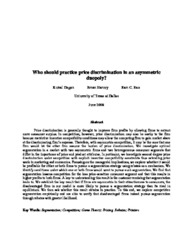Who should practice price discrimination using rebates in an asymmetric duopoly?
| dc.contributor.author | Doğan, Kutsal | |
| dc.contributor.author | Haruvy, E. | |
| dc.contributor.author | Rao, R. C. | |
| dc.date.accessioned | 2011-03-18T11:24:16Z | |
| dc.date.available | 2011-03-18T11:24:16Z | |
| dc.date.issued | 2010-03 | |
| dc.identifier.issn | 1573-711X | |
| dc.identifier.uri | http://hdl.handle.net/10679/151 | |
| dc.identifier.uri | http://www.springerlink.com/content/7430082206146202/ | |
| dc.description.abstract | Price discrimination is generally thought to improve firm profits by allowing firms to extract more consumer surplus. In competition, however, price discrimination may also be costly to the firm because restrictive incentive compatibility conditions may allow the competing firm to gain market share at the discriminating firm’s expense. Therefore, with asymmetric competition, it may be the case that one firm would let the other firm assume the burden of price discrimination. We investigate optimal segmentation in a market with two asymmetric firms and two heterogeneous consumer segments that differ in the importance of price and product attributes. In particular, we investigate second-degree price discrimination under competition with explicit incentive compatibility constraints thus extending prior work in marketing and economics. Focusing on the managerial implications, we explore whether it would be profitable for either or both firms to pursue a segmentation strategy using rebates as a mechanism. We identify conditions under which one or both firms would want to pursue such segmentation. We find that segmentation lessens competition for the less price-sensitive consumer segment and that this results in higher profits to both firms. A key to understanding this result is that segmentation leads to consumer remixing. We establish the key result that if firms are asymmetric in their attractiveness to consumers, the disadvantaged firm in our model is more likely to pursue a segmentation strategy than its rival in equilibrium. We then ask whether this result prevails in practice. To this end, we explore competitive segmentation empirically and are able to verify that disadvantaged firms indeed pursue segmentation through rebates with greater likelihood. | en_US |
| dc.language.iso | eng | en_US |
| dc.publisher | Springer Science+Business Media | en_US |
| dc.relation.ispartof | Quantitative Marketing and Economics | |
| dc.rights | openAccess | |
| dc.title | Who should practice price discrimination using rebates in an asymmetric duopoly? | en_US |
| dc.type | Article | en_US |
| dc.peerreviewed | yes | en_US |
| dc.publicationstatus | published | en_US |
| dc.contributor.department | Özyeğin University | |
| dc.contributor.authorID | (ORCID 0000-0002-4208-6389 & YÖK ID 141828) Doğan, Kutsal | |
| dc.contributor.ozuauthor | Doğan, Kutsal | |
| dc.identifier.volume | 8 | |
| dc.identifier.issue | 1 | |
| dc.identifier.startpage | 61 | |
| dc.identifier.endpage | 90 | |
| dc.identifier.wos | WOS:000273327900003 | |
| dc.identifier.doi | 10.1007/s11129-009-9078-8 | |
| dc.subject.keywords | Segmentation | en_US |
| dc.subject.keywords | Competition | en_US |
| dc.subject.keywords | Game theory | en_US |
| dc.subject.keywords | Pricing | en_US |
| dc.subject.keywords | Rebates | en_US |
| dc.subject.keywords | Printers | en_US |
| dc.identifier.scopus | SCOPUS:2-s2.0-77951022043 | |
| dc.contributor.authorMale | 1 | |
| dc.relation.publicationcategory | Article - International Refereed Journal - Institutional Academic Staff |
Files in this item
This item appears in the following Collection(s)
Share this page



